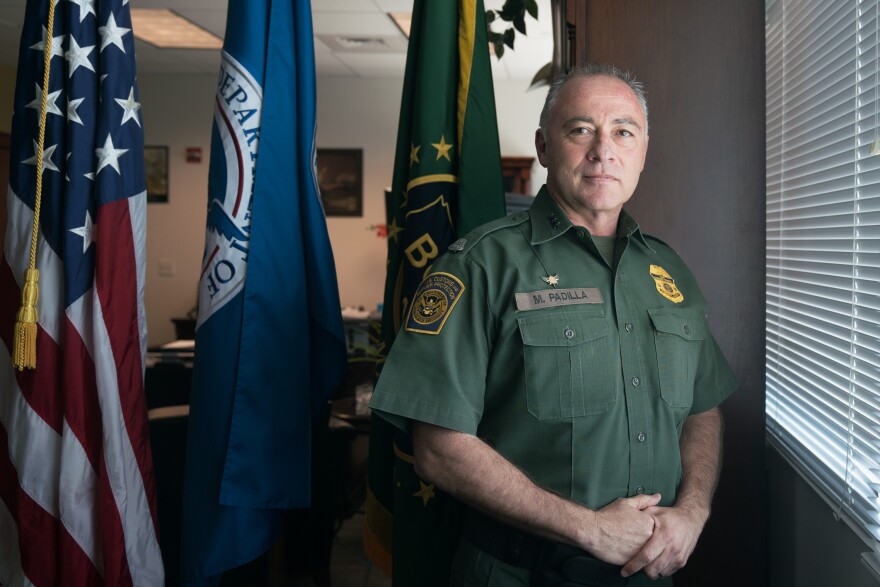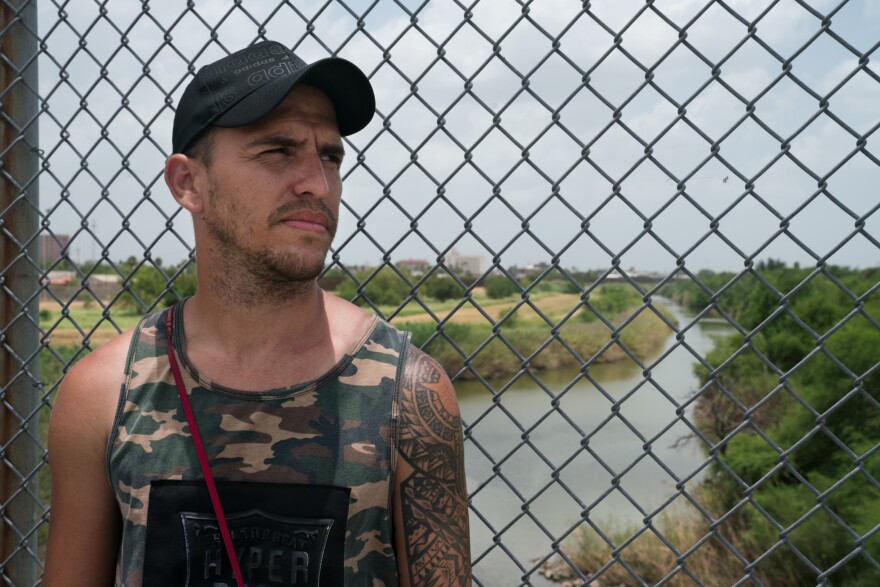The busiest section of the U.S.-Mexico border is the Rio Grande Valley. It's not unusual for Border Patrol agents to catch more than 500 immigrants a day trying to cross into the U.S. along this 55-mile stretch. In spite of increased border security and rising costs to cross, migrants are still determined to make the journey.
NPR recently spent time on both sides of the border, where immigration is part of everyday life.

Border Patrol Agent Robert Rodriguez has been patrolling this section of border near McAllen, Texas, for about 10 years. He says this stretch of the border wall used to be much busier a decade ago.
"It was very common to see a group of 40, 50 coming across in this area," Rodriguez says. "This has gone down to about half, even less."

The Rio Grande is the border line. Rodriguez says almost nobody tries to cross here without the help of cartels — who have spent years learning how best to evade the authorities.
He says those who enter the U.S. illegally here fall into two general groups: Half are smuggling drugs or people and don't want to be found. The other half want to claim asylum, and they're hoping agents find them as soon as possible.

Around a bend in the road, there's a group of about 25 seeking asylum; about half are children. Most are from Central America, trying to escape gang violence. These days, 80 percent of the people who cross the border here are not from Mexico.

Dahani Gudiel came from Guatemala with three kids — a 7-year-old and 4-year-old twins. She decided to cross after her husband, who was living in Boston, died and she started receiving threats from members of a local gang.
"They said I had to pay $2,000 by Aug. 1," Gudiel says. "They told me they were watching my daughters and that if I didn't give them the money something would happen to them. So I decided to come here."
She says she told her kids they were going on vacation.

Jessica Carolina Santos Lopez came from Honduras with her 9-year-old daughter and a 10-month-old son. She said the worst part was when the smugglers put her group in a trailer for three days and the air conditioning broke. She got dizzy and threw up. Her baby got rashes from the heat.
"I was scared because I felt like I was suffocating and my son, too, so I kept putting water on him," Santos Lopez says.

The group stands in 100-degree heat for about an hour while Border Patrol agents fill out paperwork about each migrant. Agents then drive them in vans along the unpaved roads.
This group's next stop is likely to be a central processing facility in McAllen. That's where migrants are held while the government decides where they will go next. For many that's a longer-term immigration detention facility where they will remain locked up while their case works its way through the immigration courts.

Here, they'll be given silver Mylar blankets and green foam pads to lie on. They will not step outside for the duration of their stay, which lasts on average between 36 and 48 hours, and then move on through the U.S. immigration system.

The man in charge of the entire Rio Grande Valley for the Border Patrol is Manuel Padilla, who has been with Customs and Border Protection for some 30 years and came to this area in 2015.
"Until there is immigration reform, you will continue having this problem, and it will go from this administration to the next to the next. So at some point, Congress has to fix this," he says.

Migrants who want to request asylum are supposed to go to what's called a legal port of entry. On this part of the border, that's most often one of the three bridges over the Rio Grande.

On a recent Friday afternoon, a dozen people in their 20s and 30s from countries like Cuba and Nicaragua sit under a tarp on the Mexican side of one of the bridges. They say they're waiting because U.S. officials turned them away, telling them they can't process the claim at the moment because there's no room for more asylum-seekers.
But it's not clear why there is a backlog. NPR asked several U.S. agencies involved with different parts of the process and couldn't get an answer.

Alfonso Garcia sits in the shade of a big umbrella at the bridge's midpoint and writes names in a notebook. He arrived a few days ago from Cuba, on his 30th birthday. He is recording a waiting list of people who want to claim asylum. CBP officials turn people away, rather than keep an organized waiting list. Garcia's list is unofficial, but people seem to take it seriously. There are 23 people on his list.
"The American police don't care, so it's better for me to keep this organized," he says. "At least there's some order."
A family of four from Cuba approaches him, luggage in tow, and puts each one's name on the list. The father is William Moreno.
"There's nothing as important as freedom," Moreno says. "And if there's one country that understands the importance of liberty, it's the United States."


After making it into the U.S., some migrants — especially women with children — are released to a sponsor elsewhere in the U.S. as they await their day in immigration court.

At the central bus station in McAllen, asylum-seekers are dropped off in large groups. You can spot them by their ankle monitors and the manila envelopes they're holding. Some envelopes have handwritten notes with their names, bus times, a destination. On others, big bold letters that read: "Please help me; I do not speak English; what bus do I need to take? Thank you for your help."

Sister Norma Pimentel runs the Humanitarian Respite Center in Brownsville, Texas. It's administered by Catholic Charities and is located just a few blocks from the bus station.
A sign on the wall reads,"Restoring Human Dignity." It's a mantra volunteers at the center try to follow from the moment migrants walk in, offering them water, counsel and a warm shower.
"There's a sense of unbelief," Pimentel says. "You see faces break into tears and joy and there's definitely a sense of appreciation and gratitude for the fact that we're offering them a sense of welcome and a sense of 'I care about you and want to help you in every way I can.' "


This shelter offers respite, but there's still a long process ahead for people applying for asylum. And the Trump administration has narrowed the grounds for who can be granted asylum in the U.S.; most people seeking asylum because of gang and domestic violence are no longer eligible. Most of the people here will very likely have their asylum claims rejected and be sent back to the countries from which they came. According to federal data, immigration judges are granting appeals from asylum-seekers half as much as they did a year ago.
The other side of the Rio Grande
Across the bridge from Brownsville, in the Mexican city of Matamoros, migrants await an opportunity to cross into the U.S. Some plot when they can go to a legal port of entry to claim asylum. Others will try to sneak across.
A shelter called La Casa del Migrante is a stopping point for people headed to the U.S. It's also where many people who have just been deported from the U.S. seek respite as they chart their next move.
This shelter is a safe haven in an otherwise violent city. For asylum-seekers turned away at the bridge, staying too long in Matamoros can be dangerous. The cartels see an opportunity to extort money from waiting family members in the U.S.

Juan Antonio Sierra Vargas, an engineer by training, is one of the volunteers who help operate this shelter.
He says he has seen the effect of the U.S.'s increased immigration enforcement on this side of the border.
"The enforcement effort works in the sense that people don't cross alone like they used to," he says. "Now they have to use organized crime to help them at least get to the border. And the costs for helping them get into the United States have just exploded. It used to cost $1,000 to take someone to Houston. Now it costs $10,000."

After President Trump's election, Vargas saw a flood of people come through this shelter, trying to enter the U.S. before Inauguration Day. Vargas says the numbers fell that day, and they've stayed low ever since.
On the day we visit, most of center's 48 beds are full of deportees heading south. Vargas says people headed north are increasingly hidden in stash houses, instead of shelters like this one. He says that is because migrants now have to rely more heavily on the cartels to smuggle them to the border.
But we do meet a few people headed north.

Julio Sanchez Pacayo is from El Salvador. He spent 12 years in the U.S. and has three kids there. Four years ago, he was deported when police in Houston caught him driving without a license. Now he hopes to cross back into the U.S. This time, he says, he would do things differently.
"You have to be a lot stricter now. Things are more repressive than they were under Obama. It was freer before," Sanchez says.

Throughout the day, different people arrive at the shelter to help. Barbers-in-training give free haircuts; a nurse stops by to check everyone's blood pressure; Doctors Without Borders offers free counseling.


Alejo Rubio-Martinez, 38, from Hidalgo, Mexico, has crossed into Texas six times, and he has been deported twice.
He says he sees no reason not to cross and that there's nothing the U.S. can do to stop people from trying. His advice to those looking to cross: "If you're determined to cross, give it your all."
Copyright 2023 NPR. To see more, visit https://www.npr.org.






